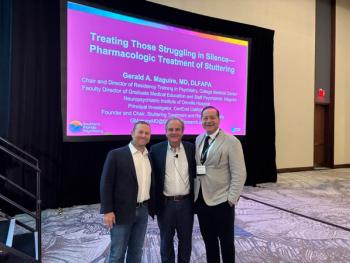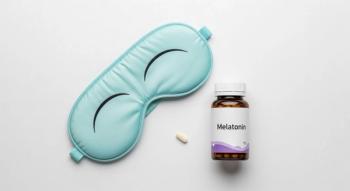
Recognize and Address the Bidirectional Relationship Between Sleep and Neuroendocrine Function to Improve TBI Outcomes
Sleep and neuroendocrine function are disrupted following TBI.
Traumatic brain injury (TBI) is a major cause of long-term disability, with many patients showing persistent symptoms of disturbed affect, hypervigilance, cognitive deficits, fatigue, and autonomic dysregulation. These chronic complaints are not uncommon, even in TBI cases with no obvious anatomical damage. Interestingly, the previously mentioned symptoms are not only associated with brain injury itself, but also with sleep and neuroendocrine dysregulation. Due to the overlap in symptoms, sleep and
TBI-Impacted Brain Regions Involved in Neuroendocrine and Sleep Regulation
Biomechanical forces at the time of TBI frequently cause damage to the diencephalon and midbrain, which house neural circuits critical for both neuroendocrine and sleep regulation.1 Particularly relevant is the impact that TBI has on cholinergic and adrenergic pathways, as well as the orexin/hypocretin system, as these pathways are intimately involved in sleep-wake regulation.2 Due to its vascular and anatomical characteristics, the hypothalamic-pituitary system is also particularly vulnerable to TBI. Hypothalamic pituitary disruption has been reported even after a mild TBI and can exist without obvious histological damage.3
Posttraumatic Endocrine Dysfunction
Multiple neuroendocrine systems are affected by
The most common pituitary hormone deficiency post-TBI is GH deficiency. In fact, a 2016 study found that, of the tested patients with chronic TBI who were GH deficient, 45% presented with severe GH deficiency.4 Patients with severe GH deficiency are also more likely to have low levels of other hormones, suggesting pituitary damage and/or altered circuitry.4 HPG axis dysregulation involves gonadotropin releasing hormone (GnRH), which will lead to alterations in sex hormones such as estradiol, progesterone, and testosterone. Although less common than other HP axis dysfunction, persistent disruption of the HPT axis can have substantial consequences given their (thyroid hormones) widespread metabolic effects. Thyroid hormone activity is also influenced by other endocrine signals and compounds, such as cortisol and gonadal hormones, that may themselves be disrupted post-TBI.5
Sleep Disturbances Following TBI
The prevalence of
Hormonal Release Is Regulated by Sleep
As mentioned previously, a bidirectional relationship exists between sleep and neuroendocrine function. Research shows that some hormones increase secretion during sleep while others decrease. Further, certain hormone levels are associated with particular stages of the sleep cycle. Slow-wave sleep (SWS) specifically is thought to be the most restorative period of sleep and is closely related to modulation of endocrine release. In addition, fragmented sleep in general, characterized by multiple awakenings and overall disruption of the normal sleep-cycle, is linked to abnormal endocrine regulation.22-23 Thus, it is reasonable to conclude that sleep disorders, such as apnea, lead to disruptions in hormonal release and that abnormal hormone release may in turn impact sleep architecture.24 Below is a summary of the regulation of specific hormones during sleep.
Growth hormone: GH is primarily secreted during the first few hours of sleep onset and is associated with SWS.
Cortisol: Cortisol is strongly associated with circadian rhythm. In healthy individuals, cortisol levels are low in the evenings, begin to rise during the second half of the night, peak in the morning and slowly decline throughout the day. Sleep begins when HPA axis activity is at its lowest point and HPA activity is increased with sleep deprivation.
Thyroid hormone: Thyroid hormones are secreted primarily in the late evening and progressively decline during the night and throughout the day.
Gonadal hormones: Gonadal hormone release is highly associated with SWS. Secretion of various sex hormones, including testosterone, estrogen, progesterone, and luteinizing hormone is increased throughout the sleep period in normal healthy adults.
Impact of Sleep and Hormonal Alterations
Hormonal and sleep disturbances have cognitive and functional consequences that will impact recovery following TBI and should be considered in the post-acute to chronic rehabilitative setting. Sleep and neuroendocrine anomalies will influence each other and contribute to post-TBI morbidity both individually and as related systems.
Deficits across a wide array of cognitive areas, including attention and memory, are greater in TBI patients with concurrent sleep disorders.25-26 Overall, there is persuasive evidence indicating that sleep supports learning and memory consolidation. Interestingly, not only has it been demonstrated that sleep is involved in memory consolidation but also in the process of forgetting.27 Sleep is also known to contribute to emotional and psychological well-being, as well as emotional processing; thus, disruptions in sleep architecture, commonly observed post-TBI, are likely to have an influence on affect.
Like sleep, hormone dysregulation may alter cognitive function and mood. Disruptions in these areas can have major impacts on healthy adults and may compound and exacerbate impairments from TBI. Hormones, along with other distinct neurochemical patterns, will interact with sleep and may influence memory consolidation. As an example, low levels of cortisol and acetylcholine are essential for memory consolidation during sleep.28-31 In addition to learning and memory, many hormones, including the ones mentioned above (thyroid hormones, GH, cortisol, gonadal hormones), are heavily implicated in mood regulation, negative mood states (such as depression), and emotional memory processing.
Concluding Thoughts
Neuroendocrine and sleep disturbances are prevalent after TBI and disruptions in one or both systems will impact posttraumatic recovery; particularly when the bidirectional relationship is considered. Due to their interconnectedness, it is crucial to consider sleep and hormonal dysregulation as related problems that may ultimately affect cognitive and functional outcome; thus, proper evaluation and treatment is of utmost importance. Given the diversity of posttraumatic SWDs, objective evaluations of sleep are recommended. When evaluating SWDs post-injury, it is also important to consider influencing factors such as age and medications. Both endocrine function and sleep are affected by age, and TBI is likely to contribute to age related disturbances. Additionally, a majority of TBI survivors are on multiple medications whose side-effects include impacting sleep. Due to the frequency of patients with TBI being on multiple medications, the idea of nonpharmacological intervention is appealing. For example, exercise is of particular interest due to its regulatory effects on both sleep and endocrine function.
Ultimately, using data gathered from both preclinical and clinical sleep and neuroendocrine research, it is possible to improve the response to rehabilitation after TBI by addressing underrecognized comorbidities. It is necessary to view TBI as a chronic disease in which pathophysiological processes will interact with sleep and neuroendocrine function.
Dr Howell is a senior neuroscientist at the Centre for Neuro Skills. She is a specialist in brain injury rehabilitation, neurodegenerative disease, and clinical research.
References
1. Meaney DF, Morrison B, Dale Bass C.
2. Saper CB, Fuller PM, Pedersen NP, et al.
3. Benvenga S, Campenni A, Ruggeri RM, Trimarchi F.
4. Kreber LA, Griesnbach GS, Ashley JA.
5. Zhang Z, Boelen A, Bisschop PH.
6. Fogelberg DJ, Hoffman JM, Dikmen S, et al.
7. Mathias JL, Alvaro PK.
8. Mazwi NL, Fusco H, Zafonte R.
9. Sandsmark DK, Elliott JE, Lim MM. Sleep-wake disturbances after traumatic brain injury: synthesis of human and animal studies. Sleep. 2017;40(5):zsx044.
10. Wolfe LF, Sahni AS, Attarian H.
11. Shekleton JA, Parcell DL, Redman JR, et al.
12. Modarres MH, Kuzma NN, Kretzmer T, et al.
13. Parcell DL, Ponsford JL, Rajaratnam SMW, Redman JR.
14. Parcell DL, Ponsford JL, Redman JR, Rajaratnam SMW.
15. Gardani M, Morfiri E, Thomson A, et al.
16. Ouellet MC, Beaulieu-Bonneau S, Morin CM.
17. Baumann CR, Werth E, Stocker R, et al.
18. Verma A, Anand V, Verma NP.
19. Kempf J, Werth E, Kaiser PR, et al.
20. Imbach LL, Bucjele F, Valko PO, et al.
21. Chen PY, Tsai PS, Chen NH, et al.
22. Stamatakis KA, Punjabi NM.
23. Tasali E, Leproult R, Ehrmann DA, Van Cauter E.
24. Harper RM, Kumar R, Macey PM, et al.
25. Mahmood O, Rapport LJ, Hanks RA, Fichtenberg NL.
26. Wilde MC, Castriotta RJ, Lai JM, et al.
27. Feld GB, Born J.
28. Gais S, Born J.
29. Kelemen E, Bahrendt M, Born J, Inostroza M.
30. Mitra A, Snyder AZ, Hacker CD, et al.
31. Plihal W, Born J.
Newsletter
Receive trusted psychiatric news, expert analysis, and clinical insights — subscribe today to support your practice and your patients.













